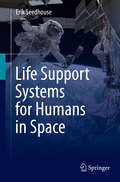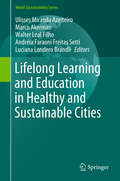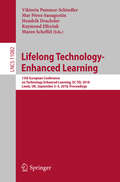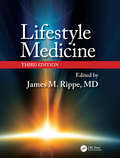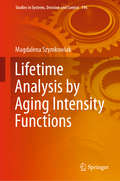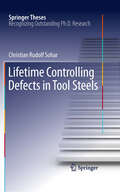- Table View
- List View
The Life Scientific: Inventors
by Anna BuckleyWhat does it take to be an inventor? Judging by the ingenious individuals who have come into The Life Scientific studio in the last eight years, there is no simple answer. Mathematicians, electricians, molecular biologists and mechanics can all transform lives. Some think with their hands, others make things in their minds. Most have a vision of the future. All are driven by a passionate determination to solve problems.These intimate accounts, based on interviews recorded for the popular BBC Radio 4 programme The Life Scientific, chart the life journeys of scientists and engineers working in Britain today from childhood interests to innovation. Explaining what they did when and why, they make science seem straightforward and exciting, revealing moments of disappointment, creativity, frustration and joy. The result is an illuminating collection of biographical short stories that make scientists and the work they do accessible to us all.
Life Support Systems for Humans in Space
by Erik SeedhouseLife support systems are an integral part of crewed spacecraft designs and habitation systems. This textbook introduces the LSS capabilities that sustain humans who live and work in space, and it is written at a level appropriate for both undergraduate and postgraduate students.The book begins with the basics of space physiology before detailing the features that make up different kinds of life support systems. It includes concise descriptions of how atmospheric pressure is monitored, how oxygen levels are maintained, how waste management is achieved and how water is recycled, and also describes the processes of fire detection and suppression. Several chapters are devoted to chronicling the evolution of life support systems through the decades. Each chapter includes a list of learning objectives, summary sections and review questions. Additionally, various analogs for spaceflight life support systems are examined, including nuclear submarines and our natural life support system here on Earth! Overall, this book serves as an approachable primer for any student seeking to understand the intricacies of spacecraft life support systems.
Lifeline Engineering Systems: Network Reliability Analysis and Aseismic Design
by Jie Li Wei LiuThis book, for the first time, introduces comprehensively all main topics of lifeline earthquake engineering, including the structure analysis, network evaluation, and network design. The distinctive features involved in this book are the construction of theories and methods for stochastic analysis of structures based the physical idea, probability analytical algorithms for network evaluation by employing Boolean Algebra, functional evaluation of water distribution networks using hydraulic analysis, and network design methods by employing genetic, simulated annealing, and hybrid algorithms.
Lifelong Learning and Education in Healthy and Sustainable Cities (World Sustainability Series)
by U. M. Azeiteiro M. Akerman W. Leal Filho A.F.F. Setti L. L. BrandliThis book presents essential insights into lifelong learning and education in healthy and sustainable cities, providing a basis for strategies to help achieve the 2030 Agenda sustainable development and health promotion goals. The interface between environment, health and lifelong learning is fundamental to attaining these goals, and as such, the book gathers interdisciplinary reflections from researchers, educators and other experts concerning the links between environmental quality, human health, human education and well-being, and addressing inequality, unplanned urbanization, migration, lifestyles, and consumption and production patterns. Topics include: Urban planning to address inequality in health and urban poverty; Healthy cities and healthy environments; Governance for sustainable development; Social determinants of health oriented on sustainable development goals; Education and lifelong learning for sustainability; Energy security, access and efficiency; Sustainable cities, buildings and infrastructure.
Lifelong Learning in the Digital Age: Sustainable for all in a changing world (IFIP Advances in Information and Communication Technology #137)
by Tom J. Van Weert Mike KendallLifelong Technology-Enhanced Learning: 13th European Conference on Technology Enhanced Learning, EC-TEL 2018, Leeds, UK, September 3-5, 2018, Proceedings (Lecture Notes in Computer Science #11082)
by Viktoria Pammer-Schindler Mar Pérez-Sanagustín Hendrik Drachsler Raymond Elferink Maren ScheffelThis book constitutes the proceedings of the 13th European Conference on Technology Enhanced Learning, EC-TEL 2018, held in Leeds, UK, in September 2018.The 42 full and short papers, 7 demo papers, and 23 poster papers presented in this volume were carefully reviewed and selected from 142 submissions. This year, the European Conference on Technology-Enhanced Learning (EC-TEL) will engage researchers, practitioners, educational developers, entrepreneurs and policy makers in a joint discussion on how to put science, technology and practice at the service of learning to embrace these challenges on the topic: Lifelong technology enhanced learning: Dealing with the complexity of 21st century challenges. Chapter "" is available open access under a Creative Commons Attribution 4.0 International License via link.springer.com.
Lifestyle and Nature: Integrating Nature Technology to Sustainable Lifestyles
by Ryuzo FurukawaEnvironmental constraints are becoming increasingly severe, and now more than ever it is time that we confront head-on the change from an "underground resources" type of civilization to one with a new way of life and technology that embraces a sense of nature. To do so, we need to understand the process of the civilization change. We must change our way of thinking to backcasting in order to design future lifestyles and learn from the elderly who lived with nature under severe environmental constraints more than 70 years ago. We must also learn from nature directly, the only sustainable society on earth. This book introduces Bio-TRIZ and ontology engineering to match and find technologies needed for spiritually affluent lifestyles. It provides many examples of Japanese cities that conducted lifestyle design projects based on nature technology. The book is a great reference for graduate-level students of environmental studies and engineering and for researchers in innovation, social science, engineering, and public policy, especially those with an interest in lifestyle change for a sustainable society.
Lifestyle and Nature: Integrating Nature Technology to Sustainable Lifestyles
by Ryuzo Furukawa Yuko Suto Emile H. Ishida Takeshi YamauchiEnvironmental constraints are becoming increasingly severe, and now more than ever it is time that we confront head-on the change from an "underground resources" type of civilization to one with a new way of life and technology that embraces a sense of nature. To do so, we need to understand the process of the civilization change. We must change our way of thinking to backcasting in order to design future lifestyles and learn from the elderly who lived with nature under severe environmental constraints more than 70 years ago. We must also learn from nature directly, the only sustainable society on earth. This book introduces Bio-TRIZ and ontology engineering to match and find technologies needed for spiritually affluent lifestyles. It provides many examples of Japanese cities that conducted lifestyle design projects based on nature technology. The book is a great reference for graduate-level students of environmental studies and engineering and for researchers in innovation, social science, engineering, and public policy, especially those with an interest in lifestyle change for a sustainable society.
Lifestyle Medicine, Fourth Edition (Lifestyle Medicine Ser.)
by James M. RippeThe fourth edition of Dr. James Rippe’s classic Lifestyle Medicine textbook continues to lead and inform the rapidly growing field of lifestyle medicine. This is the discipline that focuses on the impact of daily habits and actions on both short- and long-term health and quality of life.The first edition of this comprehensive work named the field of lifestyle medicine in the academic medical literature. The fourth edition continues to span and expand the field and offers extensive evidence-based literature in virtually every aspect of lifestyle medicine. This Textbook, edited by cardiologist Dr. James Rippe, who is a leading lifestyle medicine researcher, represents the combined wisdom and recommendations of over 325 experts in virtually every aspect of lifestyle medicine. Chapter authors have been chosen because of their background as leaders in various aspects of lifestyle medicine.Lifestyle Medicine, Fourth Edition contains extensive sections on the treatment and prevention of coronary heart disease,stroke, cancer, diabetes, obesity, substance abuse, dementia, and many other clinical conditions. Key lifestyle modalities such as physical activity, nutrition, weight management, sleep, stress reduction, and positive connections with other humans are supported by detailed discussion and state-of-the-art evidence. The expanded section on behavioral medicine provides an important framework for these discussions. Every chapter has been completely revised and many new topics added, such as lifestyle medicine for nursing, psychiatry, and preventive neurology.The fourth edition of this classic text continues to serve as the leading, comprehensive textbook in lifestyle medicine. The original has been called the “indispensable bible” of lifestyle medicine, and the fourth edition of this work continues to justify this designation.There is no longer any serious doubt that daily habits and actions have a significant impact on multiple aspects of health. The fourth edition of Lifestyle Medicine provides the scientific evidence to support this assertion and will serve as an invaluable reference and guide, not only to lifestyle medicine practitioners but to all primary care physicians, subspecialty physicians, nurses, and other healthcare practitioners.
Lifestyle Medicine, Fourth Edition
The fourth edition of Dr. James Rippe’s classic Lifestyle Medicine textbook continues to lead and inform the rapidly growing field of lifestyle medicine. This is the discipline that focuses on the impact of daily habits and actions on both short- and long-term health and quality of life.The first edition of this comprehensive work named the field of lifestyle medicine in the academic medical literature. The fourth edition continues to span and expand the field and offers extensive evidence-based literature in virtually every aspect of lifestyle medicine. This Textbook, edited by cardiologist Dr. James Rippe, who is a leading lifestyle medicine researcher, represents the combined wisdom and recommendations of over 325 experts in virtually every aspect of lifestyle medicine. Chapter authors have been chosen because of their background as leaders in various aspects of lifestyle medicine.Lifestyle Medicine, Fourth Edition contains extensive sections on the treatment and prevention of coronary heart disease,stroke, cancer, diabetes, obesity, substance abuse, dementia, and many other clinical conditions. Key lifestyle modalities such as physical activity, nutrition, weight management, sleep, stress reduction, and positive connections with other humans are supported by detailed discussion and state-of-the-art evidence. The expanded section on behavioral medicine provides an important framework for these discussions. Every chapter has been completely revised and many new topics added, such as lifestyle medicine for nursing, psychiatry, and preventive neurology.The fourth edition of this classic text continues to serve as the leading, comprehensive textbook in lifestyle medicine. The original has been called the “indispensable bible” of lifestyle medicine, and the fourth edition of this work continues to justify this designation.There is no longer any serious doubt that daily habits and actions have a significant impact on multiple aspects of health. The fourth edition of Lifestyle Medicine provides the scientific evidence to support this assertion and will serve as an invaluable reference and guide, not only to lifestyle medicine practitioners but to all primary care physicians, subspecialty physicians, nurses, and other healthcare practitioners.
Lifestyle Medicine, Third Edition
by James M. RippeThe field of lifestyle medicine, which is the study of how daily habits and actions impact on both short- and long-term health and quality of life, continues to expand globally. The scientific and medical literature that supports the success of these lifestyle habits and actions is now overwhelming. Thousands of studies provide evidence that regular physical activity, maintenance of a health body weight, following sound nutritional practices, stress reduction, and other good practices all profoundly impact both health and quality of life. Following its predecessors, Lifestyle Medicine, Third Edition, is edited by lifestyle medicine pioneer, cardiologist Dr. James Rippe. This edition has been thoroughly updated and represents the expert opinions of 20 section editors as well as more than 150 expert chapter authors whose knowledge span all aspects of this emerging discipline. Topics cover lifestyle medicine practices including regular physical activity, proper nutrition, and weight management. These principles are applied to the prevention and or treatment of a wide variety of chronic conditions ranging from heart disease and diabetes to cancer, mental health, addiction, and injury prevention. This book serves as evidence base for individuals who wish to practice lifestyle medicine or incorporate some of its principles into either general medicine or subspecialty practice. It provides valuable information to healthcare workers in the fields of nutrition, exercise physiology, psychology, behavioral medicine, health promotion, and public policy where lifestyle medicine principles play an ever-increasing role.
Lifestyle Medicine, Third Edition (Lifestyle Medicine Ser.)
by James M. RippeThe field of lifestyle medicine, which is the study of how daily habits and actions impact on both short- and long-term health and quality of life, continues to expand globally. The scientific and medical literature that supports the success of these lifestyle habits and actions is now overwhelming. Thousands of studies provide evidence that regular physical activity, maintenance of a health body weight, following sound nutritional practices, stress reduction, and other good practices all profoundly impact both health and quality of life. Following its predecessors, Lifestyle Medicine, Third Edition, is edited by lifestyle medicine pioneer, cardiologist Dr. James Rippe. This edition has been thoroughly updated and represents the expert opinions of 20 section editors as well as more than 150 expert chapter authors whose knowledge span all aspects of this emerging discipline. Topics cover lifestyle medicine practices including regular physical activity, proper nutrition, and weight management. These principles are applied to the prevention and or treatment of a wide variety of chronic conditions ranging from heart disease and diabetes to cancer, mental health, addiction, and injury prevention. This book serves as evidence base for individuals who wish to practice lifestyle medicine or incorporate some of its principles into either general medicine or subspecialty practice. It provides valuable information to healthcare workers in the fields of nutrition, exercise physiology, psychology, behavioral medicine, health promotion, and public policy where lifestyle medicine principles play an ever-increasing role.
Lifetime Analysis by Aging Intensity Functions (Studies in Systems, Decision and Control #196)
by Magdalena SzymkowiakThis book addresses a range of aging intensity functions, which make it possible to measure and compare aging trends for lifetime random variables. Moreover, they can be used for the characterization of lifetime distributions, also with bounded support. Stochastic orders based on the aging intensities, and their connections with some other orders, are also discussed. To demonstrate the applicability of aging intensity in reliability practice, the book analyzes both real and generated data. The estimated, properly chosen, aging intensity function is mainly recommended to identify data’s lifetime distribution, and secondly, to estimate some of the parameters of the identified distribution. Both reliability researchers and practitioners will find the book a valuable guide and source of inspiration.
Lifetime Controlling Defects in Tool Steels (Springer Theses)
by Christian Rudolf SoharIn this thesis Christian Sohar describes his investigation into the gigacycle fatigue behavior of tool steels. In an interdisciplinary approach he uses knowledge and methods from a wide variety of disciplines including materials science, metallurgy, chemistry, physics and mechanical engineering. Christian gives a general introduction into steel tools and fatigue in materials. Later he extensively discusses the experimental techniques and results. Indeed it is the detail of the content in this thesis which makes it an invaluable resource for students entering the field and scientists working in related disciplines. Overall, the thesis helps us understand more about the mechanical behavior of metallic materials with complex microstructure and high hardness.
Lifetime Environmental Impact of Buildings (SpringerBriefs in Applied Sciences and Technology)
by Marc Méquignon Hassan Ait HaddouThis work discusses the impact of the life of buildings on sustainable development methods. The study of the lifespan of the building is used to assess and manage the environmental impacts associated with all the stages of a product's life, from raw material extraction through to repair, maintenance and 'end of life' scenarios. While several papers have discussed thegreenhouse gas emissions of buildings, less research has been done on how these are affected by the lifespan of the building. This book serves to highlight the pertinence of this factor and contributes to providing new ideas on efficiency within the lifecycle assessment of a structure.
Lifetime Estimation of Welded Joints
by Tadeusz LagodaIn the paper the author attempts to assess the fatigue life of chosen welded joints. It focuses especially on chosen problems that accompany deter- nation of the fatigue life of welded joints, taking into consideration the strain energy density parameter. Chapter 2 describes the welded joint as a stress concentrator. The state of stress and strain in the notch are described and theoretical and fatigue coefficients are indicated. The fatigue coef- cient of the notch effect is estimated on the basis of fictitious radius in the notch root. Chapter 3 presents a model of fatigue life assessment under uniaxial stress state with statistical handling of data presented. The new energy model of fatigue life assessment, which rests upon the analysis of stress and strain in the critical plane, is described in detail in chapter 4. The principle of such a description is presented in the uniaxial as well as in - axial state of loading. Chapter 5 contains the analysis of tests of four ma- rials subjected to different loadings: cyclic, variable-amplitude with Ga- sian distribution, and variable amplitude with Gaussian distribution and overloading for symmetric and pulsating loading. The analysis is based on the determined fatigue characteristics for all the considered materials. Chapter 6 shows the application of the model in the fatigue life assessment in the complex state of loading (bending with torsion of flange-tube and tube-tube joints) based on fatigue research of steel and aluminum welded joints carried out in well-known German centres.
Lifetime-Oriented Structural Design Concepts
by Friedhelm StangenbergSafety and reliability are important for the whole expected service duration of an engineering structure. Therefore, prognostical solutions for different building types are needed and uncertainties have to be handled. Life-cycle strategies to control future structural degradations by concepts of appropriate design have to be developed, in case including means of inspection, maintenance, and repair. Aspects of costs and sustainability also matter. The Cooperative Research Center for Lifetime-Oriented Design Concepts (SFB 398) at Ruhr University in Bochum combines the wide range of scientific topics between structural engineering, structural and soil mechanics and material sciences regarding structural lifetime management in this present extraordinary monolithic format. The characterization and modeling of lifetime-related external actions of multiple origin are presented in this book as well as the physical description, the modeling and the validation of material degradation. Adaptive numerical methods and simulation techniques are provided for the lifetime-oriented design concepts to forecast material and structural degradation. Stochastic aspects, mathematical optimization methods and interactions between various influences are included. Thus, a solid basis is provided for future practical use and also for standardization of structural design with respect to lifetime-prediction.
Lifetime Reliability-aware Design of Integrated Circuits
by Mohsen Raji Behnam GhavamiThis book covers the state-of-the-art research in design of modern electronic systems used in safety-critical applications such as medical devices, aircraft flight control, and automotive systems. The authors discuss lifetime reliability of digital systems, as well as an overview of the latest research in the field of reliability-aware design of integrated circuits. They address modeling approaches and techniques for evaluation and improvement of lifetime reliability for nano-scale CMOS digital circuits, as well as design algorithms that are the cornerstone of Computer Aided Design (CAD) of reliable VLSI circuits. In addition to developing lifetime reliability analysis and techniques for clocked storage elements (such as flip-flops), the authors also describe analysis and improvement strategies targeting commercial digital circuits.
Lifetime Spectroscopy: A Method of Defect Characterization in Silicon for Photovoltaic Applications (Springer Series in Materials Science #85)
by Stefan ReinLifetime spectroscopy is one of the most sensitive diagnostic tools for the identification and analysis of impurities in semiconductors. Since it is based on the recombination process, it provides insight into precisely those defects that are relevant to semiconductor devices such as solar cells. This book introduces a transparent modeling procedure that allows a detailed theoretical evaluation of the spectroscopic potential of the different lifetime spectroscopic techniques. The various theoretical predictions are verified experimentally with the context of a comprehensive study on different metal impurities. The quality and consistency of the spectroscopic results, as explained here, confirms the excellent performance of lifetime spectroscopy.
Lifts and Escalators: A user manual
by Dieter UngerThis book offers everyone who plans, builds or operates lifts and escalators a comprehensive overview of the important topics: starting with the standards and technical rules through to the history of technology. Planning, operation, maintenance and documentation of lifts and escalators are described. Numerous meaningful color illustrations complement the text. The book serves as a reference work for operators of lifts and escalators. The many examples, tips and advice from practice make it a helpful companion in daily work.
Ligand Platforms in Homogenous Catalytic Reactions with Metals: Practice and Applications for Green Organic Transformations
by Ryohei Yamaguchi Ken-ichi FujitaServing as a user's manual for synthetic organic and catalytic chemists, this book guides chemists in the design and choice of ligands to catalyze organic reactions and apply the results for more efficient, green, and practical synthesis. • Focuses on the role of ligands in metal complexes that catalyze green organic transformations: a hot topic in the area of organic synthesis and green chemistry • Offers a comprehensive resource to help readers design and choose ligands and understand selectivity/reactivity characteristics • Addresses a gap by taking novel ligand approaches and including up-to-date discussion on hydrogen transfers and reactions • Presents important industrial perspective and provides rational explanations of ligand effects, impacts, and novelty
Ligand Platforms in Homogenous Catalytic Reactions with Metals: Practice and Applications for Green Organic Transformations
by Ryohei Yamaguchi Ken-ichi FujitaServing as a user's manual for synthetic organic and catalytic chemists, this book guides chemists in the design and choice of ligands to catalyze organic reactions and apply the results for more efficient, green, and practical synthesis. • Focuses on the role of ligands in metal complexes that catalyze green organic transformations: a hot topic in the area of organic synthesis and green chemistry • Offers a comprehensive resource to help readers design and choose ligands and understand selectivity/reactivity characteristics • Addresses a gap by taking novel ligand approaches and including up-to-date discussion on hydrogen transfers and reactions • Presents important industrial perspective and provides rational explanations of ligand effects, impacts, and novelty
Liganded silver and gold quantum clusters. Towards a new class of nonlinear optical nanomaterials (SpringerBriefs in Materials)
by Rodolphe Antoine Vlasta Bonačić-KouteckýMetallic quantum clusters belonging to intermediate size regime between two and few hundred of atoms, represent unique building blocks of new materials. Nonlinear optical (NLO) characteristics of liganded silver and gold quantum clusters reveal remarkable features which can be tuned by size, structure and composition. The two-photon absorption cross sections of liganded noble metal quantum clusters are several orders of magnitude larger than that of commercially-available dyes. Therefore, the fundamental photophysical understanding of those two-photon processes in liganded clusters with few metal atoms deserve special attention, in particularly in context of finding the mechanisms responsible for these properties. A broad range of state-of-the-art experimental methods to determine nonlinear optical properties (i.e. two-photon absorption, two-photon excited fluorescence and second harmonic generation) of quantum clusters are presented. The experimental setup and underlying physical concepts are described. Furthermore, the theoretical models and corresponding approaches are used allowing to explain the experimental observations and simultaneously offering the possibility to deduce the key factors necessary to design new classes of nanoclusters with large NLO properties. Additionally, selected studied cases of liganded silver and gold quantum clusters with focus on their NLO properties will be presented as promising candidates for applications in imaging techniques such as fluorescence microscopy or Second-Harmonic Generation microscopy.
Light: Ideas Box: Light Abn Espresso: Ideas Box: Light (Espresso: Ideas Box #2)
by Sarah RidleyJoin Polly, Kim and the rest of the Espresso team to find out all about light. Explore shadows, solar eclipses and the festival of Diwali. Plus find out why plants need light, make a rainbow spinner, learn how to paint shadows and much more!This book is part of the Espresso Ideas Box series, which have a wealth of information and ideas for exploring topics in a cross-curricular way. They are produced in association with Espresso Education, the leading digital curriculum service in the UK - used in over 10,000 primary schools.
The Light Ages: A Medieval Journey of Discovery
by Seb Falk'Compulsive, brilliantly clear and superbly well-written, it's a charismatic evocation of another world' Ian Mortimer, author of The Time Traveller's Guide to Medieval EnglandThe Middle Ages were a time of wonder. They gave us the first universities, the first eyeglasses and the first mechanical clocks as medieval thinkers sought to understand the world around them, from the passing of the seasons to the stars in the sky. In this book, we walk the path of medieval science with a real-life guide, a fourteenth-century monk named John of Westwyk - inventor, astrologer, crusader - who was educated in England's grandest monastery and exiled to a clifftop priory. Following the traces of his life, we learn to see the natural world through Brother John's eyes: navigating by the stars, multiplying Roman numerals, curing disease and telling the time with an astrolabe. We travel the length and breadth of England, from Saint Albans to Tynemouth, and venture far beyond the shores of Britain. On our way, we encounter a remarkable cast of characters: the clock-building English abbot with leprosy, the French craftsman-turned-spy and the Persian polymath who founded the world's most advanced observatory.An enthralling story of the struggles and successes of an ordinary man and an extraordinary time, The Light Ages conjures up a vivid picture of the medieval world as we have never seen it before.

